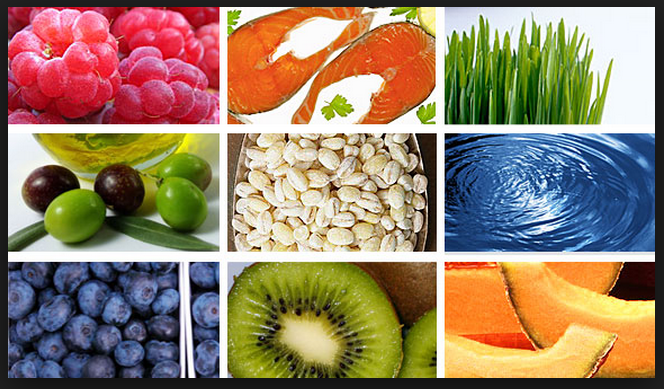by Sunny Raleigh D.O.
Regardless of whether you need some simple adjustments or a major “tune-up” in the food department, the following ideas and reminders can be helpful.
• Choose a diet based on a variety of: fresh vegetables (50+% of diet), nuts and seeds, fresh fruits, beans and legumes, lean animal proteins: especially wild caught fish and grass-fed beef, free-range chicken and turkey; healthy fats such as olive oil and avocado; organic dairy.
***Combine a variety of colorful vegetables and fruits on your plate to ensure a high intake of health promoting anti-oxidants, as well as fiber, vitamins and minerals ***
***Incorporate more of nature’s healing foods and herbs, e.g., ginger, cinnamon, capsaicin (red hot pepper) cilantro, rosemary, parsley, turmeric, marjoram, thyme, milk thistle tea, green tea***
• Follow a low-glycemic-load way of eating to keep blood sugars balanced. A low glycemic eating plan requires less insulin and helps reduce insulin resistance, which is associated with increased risk for Type 2 Diabetes. It also helps lessen related metabolic disturbances (e.g. cardiovascular & hepatic) and contributes to overall higher level of energy.
*** Eat small frequent meals 5-6x/day that combine proteins, high fiber carbohydrates (vegetables, whole grains, fruits) and healthy fats like olives, olive oil, nuts and seeds, avocado***
***Remember the basic portion control rule: one quarter carbohydrates, one quarter protein, and one half fresh salads and/or vegetables***
• Avoid: Sugars, high fructose corn syrup, white flour products, chemicals and food additives, artificial sweeteners, and processed, packaged foods in general. Avoid pro-inflammatory omega 6 fatty acids such as corn oil and sunflower oil. Avoid excess organ meats (for example, liver) which are high in inflammatory arachidonic acid.
• Choose whole, organic foods when possible. Food research (from the Environmental Working Group) indicates there are 12(+) foods we should buy organic—due to high pesticide residue content. There is also: “The Clean 15” Foods—which do not have to be organic (due to low pesticide residue).
The “Dirty Dozen” The “Clean 15”
Buy these foods “organic” Can buy “conventional”
Apples Asparagus
Blueberries (domestic) Avocado
Celery Cabbage
Grapes (imported) Cantaloupe (domestic)
Kale/Collard greens Eggplant
Lettuce Grapefruit
Nectarines (imported) Kiwi
Peaches Mango
Potatoes Mushrooms
Spinach Onions
Strawberries Pineapple
Sweet Bell Peppers Sweet corn
Sweet peas
Sweet potatoes
Watermelon
NOTE: Store all fruits and vegetables properly for longer shelf life and to avoid mold growth. Wash before eating.
• Avoid GMO foods. GMO stands for genetically modified organisms. A wide variety of foods are created today using a GMO process. Genetically modified organisms are a result of a laboratory process of ‘taking genes from one species and inserting them into another one in an attempt to obtain a desired characteristic.’ Genetic engineering of foods is considered (by many health advocate groups) to create a number of health risks; and it is a different process of “breeding” than the traditional methods.
• Stay well hydrated. We are all familiar with the general recommendation: Drink 8 cups of water per day to stay well-hydrated. But, according to The Institute of Medicine, there are other sources of fluids as well. The following foods also contribute fluids to the body: low carbohydrate, leafy vegetables and salads, healthy soups, teas, fruits and some juice (although juice can be high sugar), milk and yogurt, limited amounts of coffee. (LIMIT caffeine sources to 2-3 servings per day).
***Signs of inadequate hydration include: dry, sticky mouth, dry skin, feeling thirsty, concentrated urine with a strong smell, feeling tired or headachy, dizzy or light-headed, constipation***
***Remember to drink extra fluids with increased physical activity, in hot weather, when breast-feeding, when ill ***
See the following websites for more tips:
http://www.mayoclinic.com/health/dehydration/DS00561
• If you use nutrition supplements, check with your healthcare provider about amounts that are best for your needs. A routine Vitamin D lab test can tell you if you are deficient and need Vitamin D supplementation. Other supplements that may be helpful include omega 3 fish oil/vegan DHA omegas, whole foods-based multivitamin/minerals, calcium supplementation, and probiotics.
• Eat slowly and mindfully. Chew your food completely before taking the next mouthful.
• REMEMBER: Healthy diet, simple breathing techniques and a good exercise program all go together!


